Baltic 4 - Russia
| Baltic 2013: Part four of six |
|---|
| 1-Denmark 2-Germany 3-Estonia 4-Russia 5-Finland 6-Sweden |
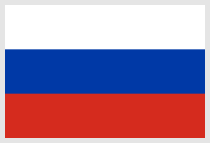 July 31-August 1, 2013: St Petersburg, Russia
July 31-August 1, 2013: St Petersburg, Russia
If there is one city on our cruise I hoped much of my adult life to see, it is St Petersburg. No two-day sightseeing tour could possibly qualify as “seeing the city,” but I was happy to take what I could get. St Petersburg was founded by Peter the Great in 1703 and so is a very young city by the standards of this part of the world. It, never Moscow, was and is the artistic heart of Russia.
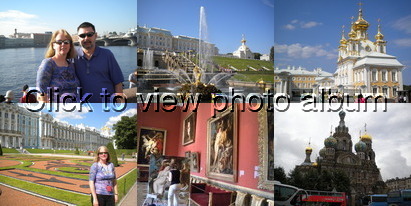 I’ve read all the great dead Russian authors. All of them have connections to the city. Pushkin and Dostoevsky lived and died there. A young Tolstoy ran up gambling debts along its famous Nevsky Prospect; Nabokov was born there and escaped to the West from the city. Many of my favorite works of fiction are set in the city: Raskolnikov killed his landlady there, the nihilist Bazarov studied there, every debutante in every 19th century Russian novel “came out” in its society, and Gogol told the story of a St Petersburg official whose nose left his face and began living a life of its own in the city.
I’ve read all the great dead Russian authors. All of them have connections to the city. Pushkin and Dostoevsky lived and died there. A young Tolstoy ran up gambling debts along its famous Nevsky Prospect; Nabokov was born there and escaped to the West from the city. Many of my favorite works of fiction are set in the city: Raskolnikov killed his landlady there, the nihilist Bazarov studied there, every debutante in every 19th century Russian novel “came out” in its society, and Gogol told the story of a St Petersburg official whose nose left his face and began living a life of its own in the city.
Tchaikovsky premiered his Pathétique Symphony in the city before dying there nine days later. Rachmaninoff studied at its Conservatory, and Shostakovich helped defend it from the Nazis (he worked as a firefighter) and commemorated the siege in his “Leningrad Symphony.”
You get the idea. I was excited to be there.
Day One
On the morning of our first of two days in Russia, we first had to present our temporary visa (obtained through our tour company) to a humorless border agent. It was a reminder that relations between Russia and the West are still chilly. Nowhere else on our cruise were we required to have a visa. The tour company’s promise to the Russian government was that we would be chaperoned during the entirety of our visit.
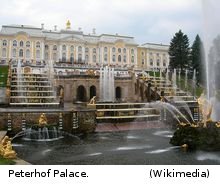 After entering the country, we were met by our tour guide Anya. She would shepherd us through our two-day visit. Alone among our five guides during this cruise, she was all business. No sense of humor or personality that she was willing to let us see. However, she was very knowledgeable, efficient, and kind.
After entering the country, we were met by our tour guide Anya. She would shepherd us through our two-day visit. Alone among our five guides during this cruise, she was all business. No sense of humor or personality that she was willing to let us see. However, she was very knowledgeable, efficient, and kind.
The first hour or so of our day was spent touring the area of St Petersburg near the Neva River in our van. We stopped for several short photo opportunities and listened to Anya’s overview of the city’s history. After this introduction, we boarded a hydrofoil for the 45-minute boat ride on the Neva and the Gulf of Finland to Peterhof Palace.
Peterhof Palace was built by Peter the Great shortly after he had the city of St Petersburg built in the first decade of the 18th century. It was his summer residence. We did not see the inside of the palace, but toured its famous gardens and saw several of the most spectacular fountains (see photo album for proof). The palace and the gardens are modeled after Versailles, where Peter spent time before he became Tsar of Russia. For all I know, they outdo the original (and according to our Russian hosts, they do). We were served a light lunch in a small restaurant located in the gardens to wrap up our visit.
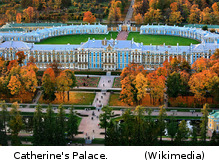 A short van ride took us from Peterhof to the St Petersburg suburb of Pushkin and its big attraction, Catherine’s Palace. We saw the inside of this one, and started to get a very good sense of why the Russian peasants were ripe for the revolution that overthrew the tsars. Room after room of gilded everything. Not just gold, but fabulously expensive marble, amber, precious stones, wood, portraiture, etc. And if it wasn’t enough to imagine what the 18th and 19th century peasantry thought of the expense, we were told how the palace was virtually destroyed by Nazi bombing during World War II only to be restored at the cost of hundreds of millions of dollars by the Soviets. I guess now that the Russians have embraced capitalism, they are getting it back one tourist at a time.
A short van ride took us from Peterhof to the St Petersburg suburb of Pushkin and its big attraction, Catherine’s Palace. We saw the inside of this one, and started to get a very good sense of why the Russian peasants were ripe for the revolution that overthrew the tsars. Room after room of gilded everything. Not just gold, but fabulously expensive marble, amber, precious stones, wood, portraiture, etc. And if it wasn’t enough to imagine what the 18th and 19th century peasantry thought of the expense, we were told how the palace was virtually destroyed by Nazi bombing during World War II only to be restored at the cost of hundreds of millions of dollars by the Soviets. I guess now that the Russians have embraced capitalism, they are getting it back one tourist at a time.
Day Two
Our second day began with a visit to a souvenir shop where we would pay for our six days of shore excursions. (We used a Russian company, Alla Tours, throughout our cruise and cannot recommend them highly enough.) At 8:30 AM we were offered free vodka shots at the door. It tasted like a harsh mouthwash to me. I guess vodka isn’t just for lunch anymore.
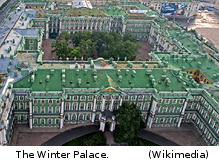 Our morning was spent touring the Hermitage Museum. It is one of the largest museums in the world (it is said to have the largest collection of paintings anywhere) and was established in the Winter Palace by Catherine the Great in 1764. It wouldn’t be possible for me to describe our experience of the place in words. Our indoor, flash-free photographs do it no justice, of course, and our three-hour walking tour didn’t give us a chance, really, to appreciate the art. But we tried. We saw the paintings and sculpture of so many masters (in no particular order): Leonardo da Vinci, Michelangelo, Rembrandt, van Gogh, Matisse, Rodin, Picasso, Chagall, Monet and dozens more familiar and unfamiliar names. To describe the experience as “overwhelming” is to understate the obvious.
Our morning was spent touring the Hermitage Museum. It is one of the largest museums in the world (it is said to have the largest collection of paintings anywhere) and was established in the Winter Palace by Catherine the Great in 1764. It wouldn’t be possible for me to describe our experience of the place in words. Our indoor, flash-free photographs do it no justice, of course, and our three-hour walking tour didn’t give us a chance, really, to appreciate the art. But we tried. We saw the paintings and sculpture of so many masters (in no particular order): Leonardo da Vinci, Michelangelo, Rembrandt, van Gogh, Matisse, Rodin, Picasso, Chagall, Monet and dozens more familiar and unfamiliar names. To describe the experience as “overwhelming” is to understate the obvious.
It was a short drive from the Winter Palace to the restaurant where we would enjoy a very good Russian meal. There we visited with Wen, an architect from San Francisco, his wife, two sisters-in-law and his mother-in-law. This fun group toured with us in four of the cities we visited on our cruise.
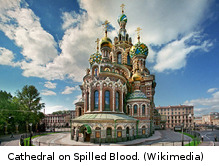 We walked in a light drizzle from the restaurant to the Cathedral of the Resurrection of Christ, much better known as “Church of the Savior on Spilled Blood.” It is so called because it was built as a memorial on the spot where Tsar Alexander II was assassinated in 1881. “Wow!” is the only way to describe this one. Outside it is stunningly and colorfully ornate; inside it is covered floor to high, domed ceiling with larger-than-life mosaics of Russian Orthodox saints. During the Soviet era, this beautiful building was used to store grain! Its restoration began in 1970 and it was reopened to the public only in 1997. Our guide Anya described her delight upon finally seeing the inside of what was until then only a beautiful facade to residents of the city.
We walked in a light drizzle from the restaurant to the Cathedral of the Resurrection of Christ, much better known as “Church of the Savior on Spilled Blood.” It is so called because it was built as a memorial on the spot where Tsar Alexander II was assassinated in 1881. “Wow!” is the only way to describe this one. Outside it is stunningly and colorfully ornate; inside it is covered floor to high, domed ceiling with larger-than-life mosaics of Russian Orthodox saints. During the Soviet era, this beautiful building was used to store grain! Its restoration began in 1970 and it was reopened to the public only in 1997. Our guide Anya described her delight upon finally seeing the inside of what was until then only a beautiful facade to residents of the city.
Our driver Yuri picked us up at the curb outside of the church and drove us to a short walking bridge that provided access to the island fortress of Petropavlovskaya (Peter and Paul Fortress). The fort was established by Peter the Great in 1703 as the city’s first line of defense against the Swedes. Its citadel was completed in 1740. Today, its centrally-located cathedral serves as the burial place for a very long line of Russian tsars. The last, Nicholas I, and his family were reinterred in it in 1998. Another building on the island functions today as the St Petersburg Mint.
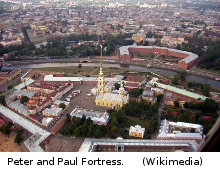 After getting a good look at the burial crypts of the Tsars, we walked off of the island and onto a boat for a one-hour tour of the city’s rivers and canals. It was a wonderful rest and an opportunity to relax at the end of our visit. Yuri picked us up one last time in the van and fought valiantly through a snarled, construction-zone traffic jam to get us back to our ship less than an hour before its scheduled departure.
After getting a good look at the burial crypts of the Tsars, we walked off of the island and onto a boat for a one-hour tour of the city’s rivers and canals. It was a wonderful rest and an opportunity to relax at the end of our visit. Yuri picked us up one last time in the van and fought valiantly through a snarled, construction-zone traffic jam to get us back to our ship less than an hour before its scheduled departure.
It was a whirlwind two days. We saw more than it was possible to take in, but enjoyed it all the same. To our Russian hosts, “spasibo” and “do svidaniya!” Back on the ship, we relaxed and retired early (not necessarily in that order). I listened to Finlandia and fell asleep thinking, “come Helsinki or high water, I’ll be ready for more in the morning.”
(See link to photo album top of this page.)
| Baltic 2013: Part four of six |
|---|
| 1-Denmark 2-Germany 3-Estonia 4-Russia 5-Finland 6-Sweden |
